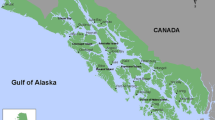Abstract
This study provides information about people’s valuation of recreational user days on public lands. The contingent valuation method is used with a random paired dichotomous choice question format. A bivariate probit model is utilized to estimate parameters of a willingness to pay function, which is used to calculate welfare measures associated with trips to three different sites and eight diverse recreational activities.
The results indicate that recreational values vary by site and by activity. Per day user values range from $ 12.15 CAN per day for trips for general rest and relaxation at a lake area popular for weekend visits to $ 35.65 CAN per day for white water canoeing on a wilderness river. Values on a per trip basis range from $ 258.11 CAN for hunting to $ 97.87 CAN for weekend lake canoeing.
Similar content being viewed by others
References
Bateman, I.J. and Willis, K.G. (1999):Valuing Environmental Preferences: Theory and Practice of the Contingent Valuation Method in the US, EU and Developing Countries. New York: Oxford University Press.
Bowler, J.M.; English, D.B.K. and Cordell, H.K. (1999): Outdoor Recreation Participation and Consumption: Projections 2000 to 2050. In Cordell, H.K.; Betz, C.J. and Bowker, J.M. (eds.)Outdoor Recreation in American Life: A National Assessment of Demand and Supply Trends. Champagne (IL): Segamore Press Inc., pp. 323–350.
Bergstrom, J.C. and De Civita, P. (1999): Status of Benefits Transfer in the United States and Canada: A Review.Canadian Journal of Agricultural Economics, vol. 47, no 1 (March), pp. 79–87.
Brouwer, R. and Spaninks, F.A. (1999): The Validity of Environmental Benefits Transfer: Further Empirical Testing.Environmental and Resource Economics, vol. 14, no 1 (July), pp. 95–117.
Cameron, T.A. and Quiggin, J. (1994): Estimation Using Contingent Valuation Data from a ‘Dichotomous Choice with Follow-Up’ Questionnaire.Journal of Environmental Economics and Management, vol. 27, pp. 218–234.
Champ, P.A.; Boyle, K. and Brown, T.C. eds. (2003):A Primer on Nonmarket Valuation. Boston: Kluwer Academic Publishers.
Dumitras, D.E. (2004):Estimation of Welfare Measure Differences for a System of Recreation Areas. Master Thesis, University of Nevada, Reno.
Economist, The (1997): Fun for the Masses.The Economist, vol. 344, issue 8028 (08/02/97), page 62.
Foot, D.K. (1989/90): The Age of Outdoor Recreation in Canada.Journal of Applied Recreation Research, vol. 15, no 3, pp. 159–178.
Foot, D.K. (2004): Leisure Futures: A Change in Demography? In Weiermair, K. and Mathies, C. (eds.)The Tourism and Leisure Industry: Shaping the Future. Binghamton (NY): The Haworth Hospitality Press, pp. 21–33.
Freeman, A.M. III (1993):The Measurement of Environmental and Resource Values: Theory and Methods. Washington D.C.: Resources for the Future.
Greene, W. H. (2003):Econometric Analysis. 5th ed. New Jersey: Prentice Hall.
Hanemann, W.M. (1984): Welfare Evaluations in Contingent Valuation Experiments with Discrete Responses.American Journal of Agricultural Economics, vol. 66, no 2, pp. 332–341.
Hanemann, W.M.; Loomis, J.B. and Kanninen, B.J. (1991): Statistical Efficiency of Double-Bounded Dichotomous Choice Contingent Valuation.American Agricultural Economics Association, vol. 73, pp. 1255–1263.
Kanninen, B.J. (1993): Optimal Experimental Design for Double-Bounded Dichotomous Choice Contingent Valuation.Land Economics, vol. 69, no 2, pp. 138–146.
Loomis, J.B. (1993):Integrated Public Lands Management: Principles and Applications to National Forests, Parks, Wildlife Refuges, and BLM Lands. New York: Columbia University Press.
Maddala, G.S. (1983):Limited Independent and Qualitative Variables in Econometrics. New York: Cambridge University Press.
Mitchell, R.C. and Carson, R.T. (1993):Using Surveys to Value Public Goods: The Contingent Valuation Method. Washington D.C.: Resource for the Future.
Nickerson, N.P. (2000): Travel and Recreation Outlook 2000: Focusing on Demographics.Montana Business Quarterly, Spring.
Rollins, K. (1997): Wilderness Canoeing in Ontario: Using Cumulative Results to Update Dichotomous Choice Contingent Valuation Offer Amounts.Canadian Journal of Agricultural Economics, vol. 45, pp. 1–16.
Smailes, P.J. and Smith, D.L. (2001): The Growing Recreational Use of State Forest Lands in the Adelaide Hills.Land Use Policy, vol. 18, pp. 137–152.
Author information
Authors and Affiliations
Corresponding authors
Additional information
Authors gratefully acknowledge Ontario Parks and the Ontario Ministry of Natural Resources, for the resources provided for this study.
Rights and permissions
About this article
Cite this article
Rollins, K., Dumitras, D.E. Estimation of median willingness to pay for a system of recreation areas. Int Rev Public Nonprofit Mark 2, 73–84 (2005). https://doi.org/10.1007/BF02893252
Received:
Accepted:
Issue Date:
DOI: https://doi.org/10.1007/BF02893252




